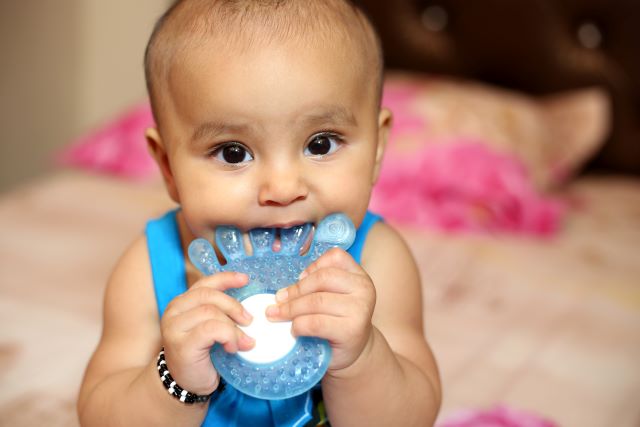Teething can be stressful for both parent and child. Toddlers often experience unpleasant symptoms, such as a teething rash, teething fever and sore gums. That is why parents may find themselves spending hours trying to console their crying child. Fortunately, there are several ways that you can soothe a toddler who is teething.

Signs Your Baby is Teething
Although all babies are different, most teething toddler experience similar symptoms when a tooth is coming in. Common teething symptoms include:
- Crankiness – When a toddler is teething, one of the first things a parent may notice is increased irritability. The pain and discomfort of teething can cause your child to be more fussy and clingy than usual.
- Swollen gums – As the tooth pushes through the gums, they may appear red and swollen.
- Drooling – Teething can stimulate an increase in saliva, which results in more drooling.
- Teething rash – According to the Children’s Hospital Los Angeles1, increased drooling will often lead to a noticeable rash around the mouth, chin, cheeks and neck while teething.
- Teething fever – Some parents claim that their teething toddler will have a slightly raised temperature. However, a temperature of 101 degrees Fahrenheit or higher could be a sign of something else, and you should consult your pediatrician1.
Now that you know how to recognize teething symptoms in your toddler, here are ways to help alleviate some of their discomfort.
1. Teething Toys
Most babies who are teething get relief when they chew on something, so a teething toy is a worthwhile investment. A teething toy provides your child with something to apply pressure to the gums, which helps with soreness. Ask your child’s doctor about the best teething toys and rings for your toddler.
However, it is best for you to avoid using frozen toys. These toys become hard and can easily break when your child chews on them. This could potentially cause more harm than good. If you want to chill the teething toy, the Cleveland Clinic recommends putting the toys in the refrigerator instead of the freezer2.
2. Cold Cloth
Again, cold is an effective treatment for teething because it helps numb the gums. Even if you don’t have teething toys, you can apply a cold cloth to the area or let your child chew on it. Not only does the cold cloth soothe the pain, but it can also reduce swelling.
3. Gripe Water
Mothers have given their babies gripe water for years to help soothe colic. However, some claim it can also be used to alleviate the discomfort that comes along with teething. It is a mixture of water and soothing herbs, such as fennel and ginger. The water may also have a small amount of sugar.
Gripe water may have other benefits as well. Babies have a tendency to drool a lot when they teethe. The salivary glands release an enzyme that upsets the stomach. The water can help alleviate an upset stomach. However, always check with your pediatrician before giving your child any herbal remedies, including gripe water or teething tablets.
4. Refrigerate a Pacifier
Some parents do not like giving their children pacifiers. However, there are some benefits to a pacifier in some situations3. A pacifier can help your teething child by numbing the gums, while the sucking action can be soothing. Try chilling a pacifier in the refrigerator for a few minutes before you give it to your child.
5. Chilled Fruit
If your baby is eating solid foods, then you should consider giving them chilled fruit. The cold temperature can help numb the area and soothe irritated gums. It can also provide relief to your older child if the six-year molars are coming in.
6. Amber Teething Necklace
Amber is a fossilized plant resin that comes out of the Baltic Sea. The amber can be polished and made into a necklace that a child can wear. Amber necklaces are popular for teething because the beads are said to release a very small amount of succinic acid, which can soothe swollen or painful gums. Although many parents advocate for this alternative option, it is not scientifically proven.
7. Anbesol Gel
This gel contains an oral anesthetic. Your child will instantly get relief when you apply it to their gums. It is important to note that this gel is not designed to be used for more than seven days at a time. You should also make sure that you avoid exceeding the recommended dosage.
8. Foot Massage
Reflexology is the practice of applying pressure to the hands and feet as a way to reduce pain and promote healing in different areas of the body. Many parents of teething toddlers choose to massage their child’s feet and toes to help with discomfort and fussiness.
9. Extra Cuddles
Your child likely wants to be close to you during this time. The extra cuddles can help them feel better. If you are nursing your child, breastfeeding can also provide them with additional comfort. Be patient, and remember, this will pass!
Do Not Use Teething Tablets
Pediatric dentist’s at Absolute Dental because the FDA has warned against the use of them. These homeopathic teething tablets containing belladonna pose an unnecessary risk to infants and children and urges consumers not to use these products and dispose of any in their possession.4
When to Be Concerned About Teething
Teething is rarely a cause for concern. You will likely be able to manage this at home. However, there are some signs that you will need to look out for. If your child has a fever that is above 101 degrees Fahrenheit, then it is time for you to call a doctor or dentist1. You should also seek medical help if your child has had a fever for more than 24 hours.
Diarrhea and vomiting are other symptoms that should not accompany teething and are a cause for concern. Additionally, if your child is inconsolable, then you will need to call a doctor or dentist.


Regular Price:
$179
With this offer, there’s no excuse not to get back on track! Schedule a complete exam and x-rays for only $39 and ensure you have a beautiful healthy smile.
RELATED: A Timeline for Your Child’s Dental Health
1 Children’s Hospital Los Angeles. 10 July 2020. Your Infant is Teething: Know the Signs and Symptoms. Retrieved on December 10, 2020 from https://www.chla.org/blog/rn-remedies/your-infant-teething-know-the-signs-and-symptoms
2 Cleveland Clinic. 6 August 2019. Teething 101: 4 Pediatrician-Approved Ways to Soothe a Teething Baby. Retrieved on December 1, 2020 from https://health.clevelandclinic.org/teething-101-4-pediatrician-approved-ways-to-soothe-a-teething-baby/
3 American Academy of Family Physicians. Pacifiers: Benefits and Risks. Retrieved December 10, 2020 from https://familydoctor.org/pacifiers-benefits-and-risks/
4 U.S. Food & Drug Administration. 9 November 2019. FDA warns consumers about homeopathic teething products. Retrieved on December 11, 2020 from: https://www.fda.gov/drugs/information-drug-class/fda-warns-consumers-about-homeopathic-teething-products


